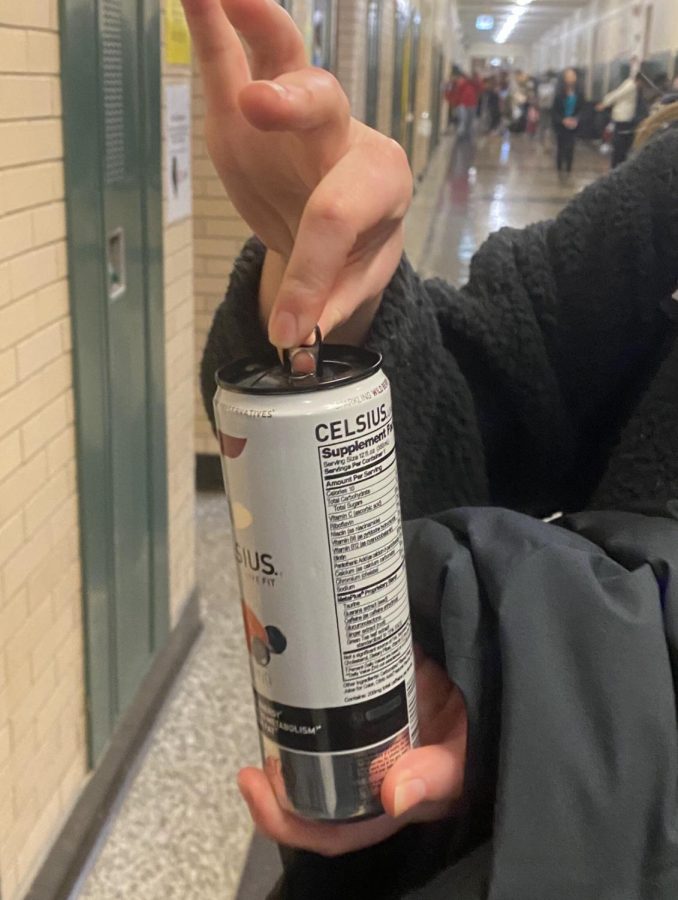What’s in your Celsius?
Junior Jane Kupka opens a can of Celsius.
When junior Anna Stemen opens her locker, she reveals an impressive stash: not of pens, snacks or notebooks, but of the increasingly popular energy drink, Celsius. Stemen said she drinks up to four a day.
“My first one is in my first and second [period],” Stemen said. “My second one is in my third period. My third one is in my later classes. And then my fourth one, if I have one, is at home.”
Why is the drink so popular?
Sold in stores around Lane Tech, such as Jewel-Osco and Circle K, Celsius is a sugar free fitness drink. For junior Jane Kupka, it’s a perfect source of caffeine.
“I need energy and I don’t like coffee,” Kupka said.
Despite being a cult favorite, the energy drink isn’t without its drawbacks and controversy. Stemen has felt the physical effects of her consistent Celsius consumption.
“I jitter a lot,” Stemen said. “I’m very, very fidgety, sweaty, and I have a lot of energy, but bad energy. My brain is just going like a million miles an hour all the time. And then I crash.”
A 12-ounce Celsius contains 200 milligrams of caffeine, double the amount that Nemours Kids Health says is safe for daily consumption by a teenager. According to Medline, common side effects of caffeine consumption are insomnia, restlessness, shakiness, dizziness and anxiety.
If a consistent Celsius drinker were to abandon the drink suddenly, they might experience these symptoms of caffeine withdrawal — including headaches, difficulty concentrating and fatigue, according to Johns Hopkins Medicine. The more caffeine someone is consuming daily, the worse the withdrawal can be.
The high caffeine content isn’t Celsius’ main claim to fame. Celsius bases their marketing on including ingredients that stimulate thermogenesis — the body’s natural process of expending energy in order to digest and metabolize food, according to the National Library of Medicine. Weight loss and diet programs often claim to harness thermogenesis to increase metabolic rate and fat burning. Celsius, intended to be consumed 15-20 minutes before a workout, claims to increase the effectiveness of physical activity and achieve these goals.
Celsius includes ingredients such as caffeine and green tea (which contains epigallocatechin-3-gallate (EGCG)), which have been hypothesized to induce thermogenesis, with mixed results in scientific trials, according to Healthline.
The Celsius website includes six peer-reviewed studies that lend evidence to Celsius’ claim of creating thermogenesis, but chemistry teacher Robert Bartelt isn’t convinced.
“I didn’t go to their website [for information] because again, their website is only going to put forth one side of the story,” he said. “Their job is to make money. And so any studies that they would put on their website are only gonna be part of the story.”
If a consumer were to take Celsius at their word, thermogenesis still isn’t a fitness miracle. According to Bartelt, when consumed independent of physical activity, Celsius’ thermogenic properties would still work, because it would force your body to find another outlet to burn calories other than a workout.
“If the calories are being burned, they need to go somewhere,” Bartelt said. “So like, are you shaking your leg? Are you now maniacally pacing? Are you engaging in a thought loop? What is causing those calories to be consumed?”
Many high school students, like Max Stevens, don’t choose Celsius for how it might benefit them during a workout.
“I consider the time of day and what I’ve already had in the day rather than its athletic effects,” she said.
Because students are consuming Celsius independent of physical activity, the unintended consequences of thermogenesis could be another reason for the symptoms Lane students have experienced. Kupka has also experienced a physical reaction after drinking Celsius.
“I’ve felt a lot of sweat and clammy hands,” she said. “A lot of heart beating early in the morning and late in the afternoon, and I can’t sleep.”
Despite all this, Kupka, Stevens and Stemen remain committed customers. To Kupka, Celsius is the better of two evils.
“When I drink like Red Bull, that makes me feel way worse and it just tastes bad,” she said. Stemen also chooses Celsius for the taste.
“Red Bull and Monsters, they taste like fruity battery acid and Celsius just tastes fruity. It’s more enjoyable,” she said.
Stevens sees Celsius as more accessible than its energy drink competitors.
“I feel like the range of flavors is a lot more laid back and mellow,” she said. “Celsius has a lot of green tea flavors or a lot of fruity flavors rather than Monster that’s like blue flavor and not an actual taste.”
Recently, Celsius has become the center of a class action lawsuit. Though Celsius claims to have no preservatives, citric acid is included in the drink. Celsius claims that the small amount of citric acid was only present to enhance taste, but have settled in order to avoid court. If you have proof of purchase of a Celsius drink from Jan. 1, 2015, to Nov. 23, 2022, you are eligible to submit a claim for a payment of up to $250. To learn more about the class action lawsuit, visit celsiusclassactionsettlement.com.
Your donations directly fund the Lane Tech student journalism program—covering essential costs like website hosting and technology not supported by our school or district. Your generosity empowers our student reporters to investigate, write, and publish impactful stories that matter to our school community.
This website is more than a publishing platform—it's an archive, a research tool, and a source of truth. Every dollar helps us preserve and grow this resource so future students can learn from and build on the work being done today.
Thank you for supporting the next generation of journalists at Lane Tech College Prep!

Charlotte Price is a junior at Lane Tech and this is her first year writing for the Champion. She dances at Dance and Music Academy in a pre-professional...




